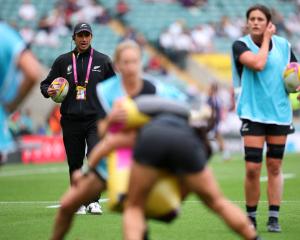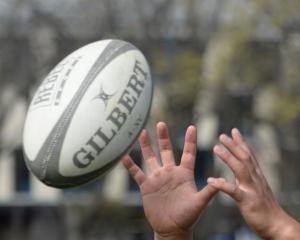
Kicking rather than running
Undoubtedly the biggest change we have seen from the Highlanders in recent years is their willingness to kick the ball. When Jamie Jospeh came on board the Highlanders fully bought into the run from everywhere idea that was popular at the time. It made them an exciting team to watch, but also a frustrating one. They would attempt elaborate, helter-skelter play from inside their own half, even inside their own 22. All too often they would make a mistake and find themselves under pressure on defence. When they did kick, often they would pass out to Tamati Ellison at centre to clear.
Compare that to the past two years. They nearly always kick from inside their own half, relying on doing so accurately and chasing well to contest the ball and apply pressure in the tackle. It means they end up tackling a lot, but they are good at that so it works. Yet they are still lethal. Instead of attacking at every chance, nowadays they will pick their moment to attack and are very hard to stop when they do so.
Defensive breakdown tactics
In the early Joseph years, the Highlanders were renowned for their ferocity at the breakdown. They would commit in numbers and look to smash opponents in contact, winning back the ball by pushing them off it. It worked for a while too, both in 2011 and in 2012 after the breakdowns began to be policed more strictly. However the physical approach saw injuries take their toll and in both seasons they fell off towards the end after promising starts.
These days they are a lot more patient. They will fan out, come up fast, tackle aggressively and then get back up quickly to reset. When under pressure they scramble well too, while also reading the play to make some dangerous spot tackles. Then when the time is right, they will go after the ball. It is the same as kicking rather than running, picking the moment to take the right option, rather than going all in all the time.
Using key attacking players
These days the Highlanders like to get it to their most destructive backs off first phase. This means either going wide straight away and setting a ruck, before coming back through forward runners, or using a winger to crash as the first receiver. It can be a risky strategy and at times leads to mistakes, but you cannot discredit their intention.
They have come a long way in that regard, as there was a time when the outside backs hardly ever got the ball in space. Hosea Gear, Ben Smith and Kade Poki were as dangerous as any back three in the competition, yet they had to go looking for the ball to get a chance. Gear in particular had some destructive games when given the ball in space, but was not used nearly enough.
Set-piece improvements
The scrum has been possibly their most improved area of the past six years. Even two years ago, when they made the playoffs for the first time in 12 years, they were getting demolished by the top teams at scrum time. That is not the case any more. It does not seem to matter what combination of players they have on, they are capable of winning ball and pushing opponents backwards. That makes a huge difference, as it provides you with a source of quality possession, as well as ensuring you are not giving up needless penalties. Likewise while the lineout was an issue, it has become a strong point, with multiple jumpers and accurate throwing making it hard to disrupt.
Kick-off receptions more secure
Perhaps the most frustrating thing about the Highlanders a few years ago was their inconsistency to secure the kick-off. They would either drop them, or take them but fail to clear the ball effectively. That left them under pressure straight after having scored, and often led to the opposition answering straight back with points. It made it hard to get away from a team, or to psychologically bury them. That has been worked on though and the current locks are superb in the air, while the inside backs are proficient in clearing for better field position.
Squad depth
Whereas five years ago the Highlanders struggled once injuries took hold, the past two years have seen them remain just as strong even with multiple players missing. You would not want to lose Aaron Smith, Lima Sopoaga, Malakai Fekitoa or Ben Smith, but elsewhere depth is not an issue.
What that means is not only are injuries less of an issue, but that they can play a more aggressive game, knowing that if their players get beaten up physically they can rest them when needed. That depth was hardly bought either, with the team largely made up of players unwanted by other teams, until they showed their talent in the south.
Kick chase and high ball ability
The kicking game the Highlanders now benefits from the outstanding aerial ability in the back three. In Ben Smith they have the best in the world at getting back high balls, while the rest of the outside backs are normally at least an even chance of winning back an accurate kick. When they do not win it back, often they will make the tackle straight away, ensuring a counter attack can't be launched. When receiving high balls, they are as good as anyone.
That was not always the case. Ben Smith used to chase hard, but his technique would go missing when contesting the ball. Hosea Gear was rock solid when receiving, but did not have the same threat chasing, while the others of that era were not renowned for their high ball ability. That limited the amount of pressure that could be applied off kicks. Nowadays putting up contestable bombs is a very viable option.
More spark
The Highlanders of five years ago were not going to cut you to pieces with pieces of individual brilliance. They were a team of hard workers who could create some good tries through ambitious play. But they did not have the fire power evident in the team of the past two years. The backline is now full of threats and consists of players who can score from anywhere on the field at any time in the game.
In the loose forwards players such as Elliot Dixon and Liam Squire have shown themselves to be more than capable of creating chances too. Having that many threats makes it hard for opponents to defend the Highlanders, as they have to do more than just focus on one of two players.












